Byzantine art
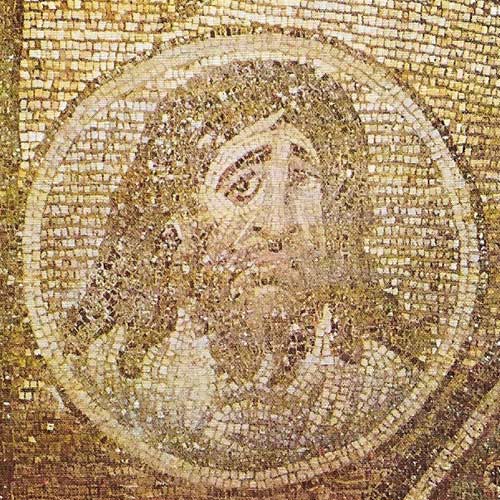
Figure 1. This mosaic medallion of St John the Baptist is from the basilica founded around 550 by Justinian on the Burning Bush site on Sinai (now St Catherine's Monastery). Its great expressiveness suggests that the decorators were from Constantinople and were able to transform a classical tragic mask into mosaic.
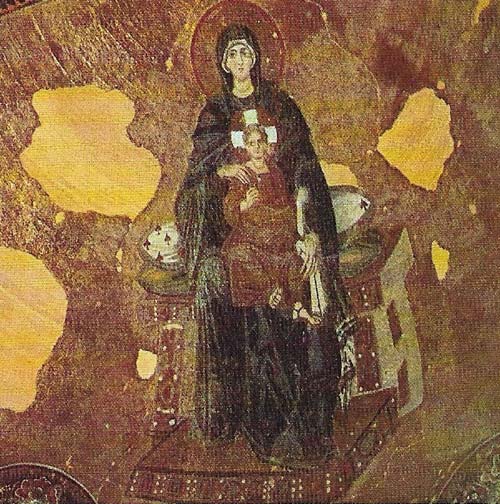
Figure 2. The mosaic of the "Enthroned Madonna and Child" in the apse of St Sophia, Istanbul, was probably unveiled by Patriarch Photius in March 867. The Patriarch claimed in a celebrated sermon that the mosaic seemed so lifelike that Mary was "not incapable of speaking".
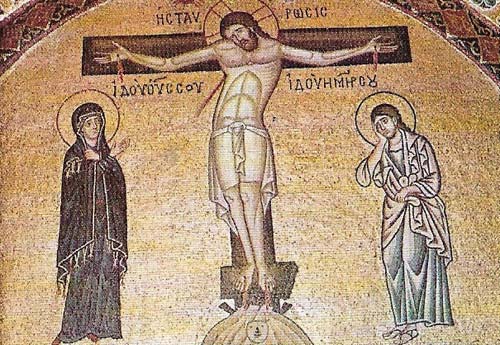
Figure 3. This "Crucifixion" is in the monastery of St Luke of Stiris, central Greece. Luke's relics attracted pilgrims, and so financed the 11th-century church. The saints here express monastic piety, and the scenes have a direct style.
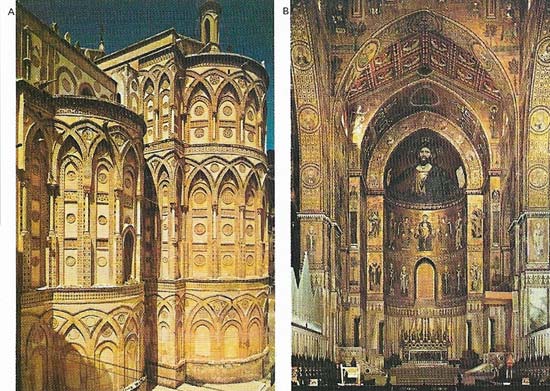
Figure 4. Monreale Cathedral (A) was founded by William II (r. 1166–1189) as a monastic cathedral to rival the archbishopric of Palermo. It is a Latin basilica, with a Greek cross-in-square sanctuary. The polychrome intricate east facade dominates the hill seen from Palermo. Christ Pantocrator is the focus of the vast mosaic interior (B). The dramatic style was the current fashion was in Constantinople.
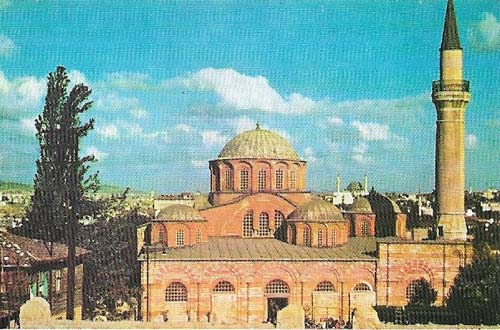
Figure 5.The Kariye Camii, Istanbul, with minaret belonging to its Turkish conversion into a mosque, is now a museum. This was the 11th-century Chora Monastery which was refounded in 1315–1321.
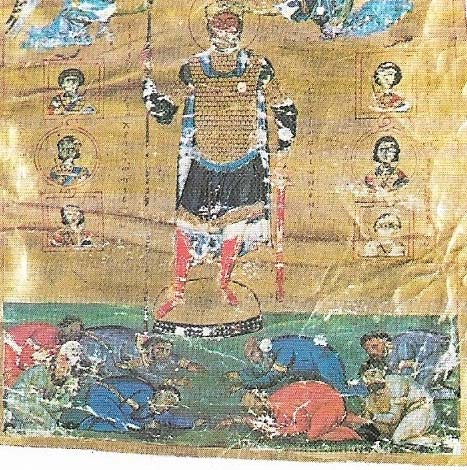
Figure 6. The frontispiece of a luxurious psalter painted in Constantinople between 1018 and 1025 commemorates the victory of Basil II over the Bulgarians. The triumphant emperor, crowned by Christ, armed by archangels, and assisted by military saints, tramples his conquered enemies underfoot. The picture both declares the power of the Byzantines and expresses their conception of sovereignty, with their emperor as representative of Jesus Christ on earth.
The small proportion of Byzantine art to survive is mostly "official" art – the aesthetic visualization of Christian beliefs, or of imperial authority, or a combination of both as the Christian Roman state. Such art was the dominant production of this society, and secular art was almost non-existent. Byzantine art, therefore, begins with the foundation of Constantinople in 330, and ends with its fall to the Turks in 1453.
"Official" art
The new capital on the site of Byzantium brought Roman art back into the geographical setting where many of its traditions, forms and media had originated. Yet Byzantine art was no mere continuation of Greco-Roman art in the service of the Orthodox Church. When 4th-century Constantinople emulated Old Rome by erecting two cochleate (spiral) columns, their sculptured reliefs (known from drawings) were developed far beyond Trajan's classical forms; they abound not merely with Christian symbols, but convey imperial triumph with an endless procession of stiff figures. The style reflects the hierarchy of the state. This new art developed in the rich cities of the eastern Mediterranean, for example in the cupola mosaics of St George in Thessaloniki (450), where a superficially Hellenistic style portrays the place of Christian martyrs in the heavens.
The first great achievements of Byzantine art belong to the reign of Justinian (527–565), whose patronage ranged from St Sophia in the capital (Figure 2) to the remote mosaics of Mt Sinai (Figure 1). The Dark Ages after Justinian, when Byzantium was under constant threat of invasion, saw a rise in the production of icons or, rather, in the superstitious cult of images or saints as the mediators for personal salvation. The Iconoclast emperors from 726 until 843 tried to impose a non-figurative religious art, comparable to medieval Muslim and Jewish societies, but the Byzantium man-aged to survive the Dark Ages and so did Christian figurative art. After Iconoclasm, the Macedonian emperors (867–1065) celebrated the Triumph of Orthodoxy with the redecoration of churches, starting with the apse of St Sophia. Progress in Byzantium customarily meant regress to past ages, and this period recreated the style of Justinian.
New patrons
More survives from the Comnenian dynasty (1081–1185) than the Macedonian. Under the Comnenes, the wealth of Byzantium significantly shifted from the emperors and bishoprics into the hands of aristocratic landowners and monasteries. Taste for gold and saturated colors stimulated an unrivalled mosaic expertise. Cubes of glass (colored or fused with gold or silver leaf), marble, even precious stones were pressed one by one into lime plaster beds on church vaults and each could be tilted to reflect the light. Vast mosaic figures in an ethereal golden glow surrounded the Byzantine worshippers. Fresco was a cheaper, but less permanent substitute. The twelfth century was a period of refinement and sophistication of earlier forms, accompanied by a growing self-consciousness: artists began to sign their works in this century. Two major mosaic decorations in Greece illuminate the middle centuries of Byzantium. The "Crucifixion" in the Monastery of St Luke (Figure 3), of the Macedonian period, delineates Christ's death as a stark episode in Church history followed by the "Resurrection". The Comnenian "Crucifixion" at Daphni still forms one unit in a dogmatic cycle, but the artist emphasizes the human aspects.
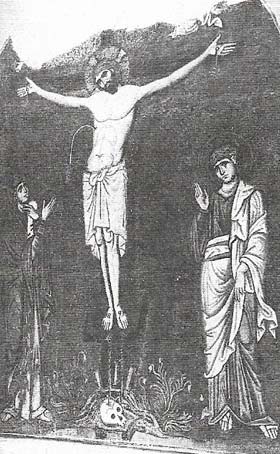 |
| The mosaics of the "Crucifixion" in the Monastery of Daphni, near Athens (c. 1100), suffered extensive restoration in the 1890s. The style is more narrative than at St Luke's Monastery and is also more emotional. |
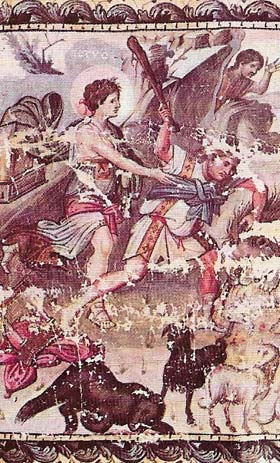 |
| David fighting a lion is one of seven author portraits opening the Paris Psalter. The atmospheric setting and female personification assisting David are devices of classical art, suggesting that the artist was an antiquarian. |
Individuality within conformity
Since Comnenian artists normally decorated a standard architecture (the cross-in-a-square cupola church) with a standard repertory (life of Christ and Mary), this may paradoxically have stimulated individuality within conformity. In Monreale the mosaicists brought to Sicily had to adapt their repertory to a different structure and larger scale (Figure 4). The challenge was to their technical expertise rather than to their inventiveness with subject-matter.
The Latin occupation of Constantinople (1204–1261) did permanent damage to the Byzantine economy, and Paleologan art (1261–1453) is on a reduced scale. The last great mosaic decoration was that of the Kariye Camii, where another aristocrat provided himself with a mortuary chapel (Figure 5). Icon production increased in this period, especially for church sanctuary screens. Paleologan artists absorbed earlier styles and made further developments. Late Byzantine art influenced Western European art; although it is harder to see what it derived from Western contacts. Whereas pictorial perspective was being developed in Italy, Byzantine compositions used architecture to punctuate the action rather than to unify the picture space. Did Byzantium stimulate, reject, or fail to understand the Western developments? Late Byzantine compositions are increasingly complicated – clarity of expression was seldom valued.
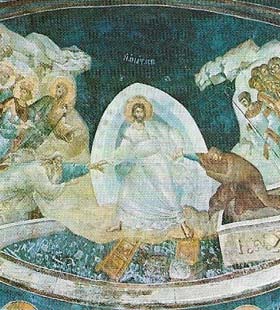 |
| The Chora (Kariye Camii) was decorated by its 14th-century refounder Theodore Metochites with mosaics, except in the south chapel, which held his tomb in a frescoed setting. The apse contained the "Anastasis" (shown here), Christ at Easter rescuing Adam and Eve from Hell. Metochites justified his greed by his use of wealth, and this decoration alleviated his guilt by promising life after death. |
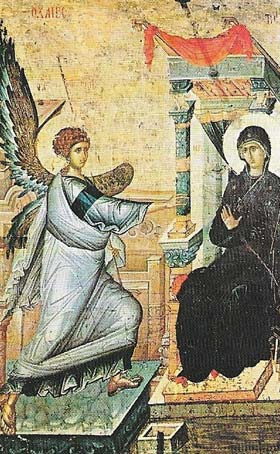 |
| The "Annunciation" is one side of a double-sided icon in the National Museum, Ohrid, Yugoslavia. The icon also portrays the Virgin, Savior of Souls. A furnishing of the Peribleptos Church (now St Clement's), the icon was perhaps sent from Constantinople and was probably painted around 1300. |
After the middle of the 14th century there was little money left for art in Constantinople, and many artists left to find work in other Orthodox societies, such as Russia. Although the consequence was to disseminate the Byzantine tradition, the destruction of imperial Constantinople in 1453 terminated creative Byzantine art.
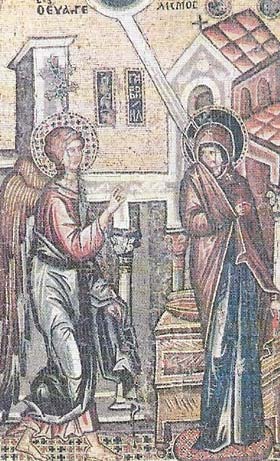 |
| In this 14th-century miniature mosaic icon of the Annunciation the minute glass cubes are set in beeswax. Such portable mosaics became fashionable among the few rich families of Paleologan Constantinople and were collected by Renaissance popes. This was virtually the only form of Byzantine art appreciated in the West. |
